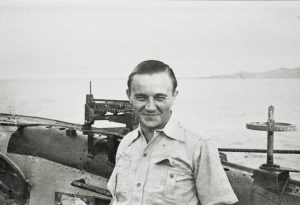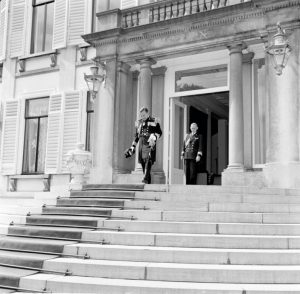A most interesting man lived until his death in Parkflat Marlot, a beautiful building in The Hague. His name is Piet de Jong, and he reached the venerable age of 101. I want to present him to you as a great example to politicians and managers.
As a young child, Piet de Jong wanted to become a sailor – and not just a sailor, but an admiral. He studied at the Royal Naval Institute, where he learned valuable lessons in working with people, in managerial skills and in taking responsibility. Standing only 1.62, he was not physically imposing. But unlike many short people who compensate for their lack of height by shouting, Piet de Jong chose to stay calm and listen to what other people had to say.
Navy
Soon after his graduation he was posted with the Submarine Department. This was a part of the Navy that suited him well, because it offered better chances to become a commanding officer. Also, submarine crews received a bonus for every hour under water.
When the Germans attacked The Netherlands in May, 1940, De Jong was executive officer on the submarine O24. Although this ship was still under construction, she sailed through mines from Rotterdam to England.

In October 1944 De Jong was appointed commanding officer of this O24 and sent to fight the war in the Pacific. In June 1945 his submarine was attacked by a Japanese destroyer. For four long hours, De Jong could only move inch by inch, and at a depth greater than the submarine could officially handle. In his own words ‘If the going gets tough, everybody is looking at the commanding officer: what is his expression. So you have to pretend that the whole situation is just a piece of cake’
After the war, De Jong held a post as aide-de-camp to the Naval minister. That brought him in contact with politicians. Later he became NATO staff officer and aide-de-camp to Queen Juliana. In 1958 he got his commission as commanding officer of the destroyer ‘Gelderland’.

In June 1959, while participating in a NATO fleet exercise, De Jong received a telegram asking him to report to The Hague. There, a new cabinet was forming, and he was on the list of candidates for the post of State Secretary for the Navy. He was carried from the ‘Gelderland’ by helicopter and photographs of De Jong hanging from a winch were published in all the newspapers.
Horizontal or vertical

Piet de Jong still wanted to become an admiral, so he agreed to become Naval Secretary on the condition that he could return to active duty after his term in office. In his new job he was quickly faced with a question that is still being asked in many organizations today: whether to organize along horizontal or vertical lines. He was a staunch supporter of the vertical organization: every part of the armed forces had its own political and financial responsibility.
Good use of humor
In 1963, after much persuasion, De Jong accepted the post of Defense minister. As Defense minister, he would have authority over all branches of the Dutch military. However, to avoid any conflict of interest, De Jong had to give up his lifelong ambition to become an admiral and resign his Naval commission. It would not be proper, for example, for De Jong as Defense minister to approve a promotion for himself as a Naval officer! As a member of government he practiced what he had learned in the Navy: stay calm, keep your nerve. And very often he used humor to relax a situation and to put things in perspective. One example: During a debate on pornography he mentioned that he considered it to be an excellent remedy against sea sickness.
Steering through stormy waters

Even after many years in Dutch politics, Piet de Jong did not think of himself as a politician. Yet he became prime minister in 1967. These were stormy times for The Netherlands, with student protests and the first taking of hostages by young men who were campaigning for a free state in the Moluccas. In these and other difficult situations De Jong showed great empathy and an understanding of the need for change. At the same time, he acted decisively when he was convinced it was necessary to intervene. He turned his cabinet into a well-oiled team and left his ministers to their own devices. His cabinet served the full four years.
Underestimated
Unfortunately his party, the Catholic People’s Party, didn’t expect Piet de Jong to attract many votes in the next election. So someone else was chosen as party leader, despite all the good work he and his cabinet had done. Today, Piet de Jong is often described as the most underestimated prime minister of The Netherlands. After leaving office, he served as a non-executive member of the boards of several companies and other organizations. As Chairman of the Board of the Westeinde Ziekenhuis in The Hague, he oversaw construction of its new hospital.
As a naval officer Piet De Jong was not afraid to speak his mind, even in the presence of superior officers. At the age of 96 he proved that he had not changed. At his party’s congress in 2010 he stood up to protest the cooperation of his party with the anti-Islamic PVV-party.
Piet de Jong: a man of no nonsense, with a lot of humor and very steadfast. I would have liked him as my boss and find him to be an inspiration.
I will tell you more about historical figures and their leadership qualities during my city walks and bicycle tours.
Listen to Piet de Jong (in Dutch):
Brandpunt Profiel Piet de Jong
Piet de Jong – 100 jaar
J.W.L. Brouwer, J. van Merriënboer
P.J.S. de Jong: een biografie : Van Buitengaats naar Binnenhof
SDU 2001


